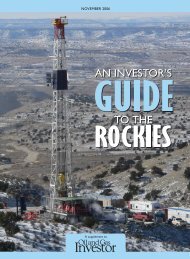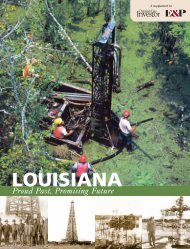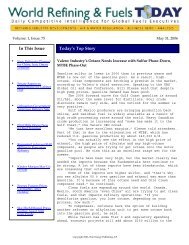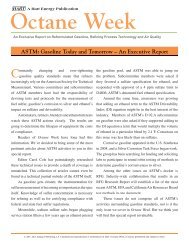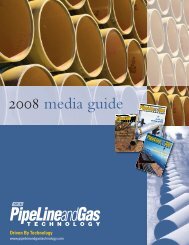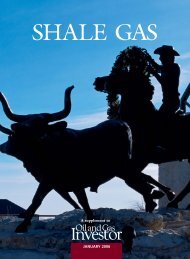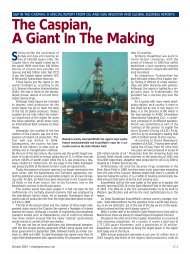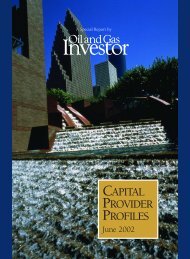Coalbed - Oil and Gas Investor
Coalbed - Oil and Gas Investor
Coalbed - Oil and Gas Investor
You also want an ePaper? Increase the reach of your titles
YUMPU automatically turns print PDFs into web optimized ePapers that Google loves.
A Supplement to<br />
<strong>Investor</strong><br />
<strong>Oil</strong> <strong>and</strong> <strong>Gas</strong><br />
OPPORTUNITIES IN COALBED METHANE<br />
DECEMBER 2002
Simply put, Evergreen<br />
Resources is a<br />
consistent industry leader<br />
in unconventional natural<br />
gas development.<br />
Key benchmarks include:<br />
• Lowest finding <strong>and</strong><br />
development costs.<br />
• Reserve replacement<br />
efficiency.<br />
• Full-cycle economics.<br />
• Vertical integration.<br />
A SIMPLE STORY IN A COMPLEX INDUSTRY
A supplement to<br />
Hart Publications,<br />
Chemical Week Associates<br />
4545 Post Oak Place, Suite 210<br />
Houston, Texas 77027-3105<br />
713-993-9320<br />
Fax: 713-840-8585<br />
www.<strong>Oil</strong><strong>and</strong><strong>Gas</strong><strong>Investor</strong>.com<br />
BRAD HOLMES, Publisher<br />
Ext. 140, bholmes@chemweek.com<br />
LESLIE HAINES, Editor<br />
Ext. 151, lhaines@chemweek.com<br />
NISSA DARBONNE, Managing Editor<br />
Ext. 165, ndarbonne@chemweek.com<br />
PEGGY WILLIAMS, Senior Exploration Editor<br />
303-756-6824, mwilliams@chemweek.com<br />
Contributing Editors:<br />
W.H. LEACH JR.<br />
STEPHEN D. SCHWOCHOW<br />
DAVID WAGMAN<br />
MARC CONLY, Art Director<br />
BOB MCGARR, Regional Sales Manager<br />
Ext. 144, bmcgarr@chemweek.com<br />
SHELLEY LAMB, Regional Sales Manager<br />
Ext. 118, slamb@chemweek.com<br />
BOB JARVIS, Vice President, Hart Publications,<br />
<strong>and</strong> Group Publisher, Finance & Power Publications<br />
Ext. 130, bjarvis@chemweek.com<br />
RICHARD A. EICHLER, President, Hart Publications<br />
MARIO G. DI UBALDI, Executive VP, Chemweek Group<br />
BILL RUTLEDGE, Director of Conferences<br />
MICHAEL D. KRAUS, VP Manufacturing<br />
KENNETH TURTORO, VP & Circulation Director<br />
STEPHEN J. SCHWARTZ, Group VP<br />
LYN TATTUM, Group VP<br />
RICHARD J. ZANETTI, Group VP<br />
KEVIN F. HIGGINS, VP & CFO<br />
MICHAEL SILBER, President & CEO<br />
OPPORTUNITIES IN COALBED METHANE<br />
<strong>Coalbed</strong>-methane gas production is taking a bigger share of the North American energy<br />
supply mix at a time when conventional gas supplies are harder to find, more expensive<br />
to drill, <strong>and</strong> quicker to decline. Aggressive drilling, research into new technologies <strong>and</strong><br />
federal tax incentives have made CBM plays increasingly viable from an economic <strong>and</strong> technical<br />
st<strong>and</strong>point.<br />
CBM development has taken off not only in the storied San Juan <strong>and</strong> Powder River basins<br />
of New Mexico <strong>and</strong> Wyoming, where there has been significant activity for 20 years. It has<br />
spread to 11 other U.S. basins where the potential is only starting to be realized.<br />
Across the U.S., coalbed-methane production now accounts for close to 1.5 trillion cubic feet<br />
(Tcf) of gas per year—or 10% of total annual gas production—<strong>and</strong> 9.5% of proved U.S. gas<br />
reserves. Proved CBM reserves are estimated to total 17.5 Tcf, <strong>and</strong> the overall potential may be<br />
exponentially greater.<br />
The future of CBM production looks bright. In Wyoming alone, where CBM occupies a position<br />
of true prominence, daily output could average 3 billion cubic feet per day by 2010. A wave<br />
of exploration is establishing new production in the Green River, Piceance <strong>and</strong> Cherokee basins.<br />
Some 20 independents are chasing these reserves in the Illinois Basin, <strong>and</strong> activity along the<br />
Texas Gulf Coast <strong>and</strong> in Alaska is set to take off.<br />
Pilot projects are under way in Alberta, Canada, as well, as that country begins to explore<br />
the ramifications of declining conventional gas production <strong>and</strong> the potential for new CBM development.<br />
Wyoming consistently ranks second only to Texas in the number of drilling permits issued<br />
per year, <strong>and</strong> the reason is the Powder River Basin.<br />
Other U.S. basins may grow to exceed the production of better-known ones during the coming<br />
decade as gas dem<strong>and</strong> increases <strong>and</strong> traditional Lower 48 supplies diminish. As long as the<br />
CBM business remains economic, there will be producers going after the once-neglected gas.<br />
They will need technology <strong>and</strong> capital, <strong>and</strong> this report explains how today’s CBM producers<br />
are accessing both, as well as describing where CBM producers may drive their stakes next.<br />
—Leslie Haines, Editor<br />
CBM-3<br />
Table of Contents<br />
CBM <strong>Investor</strong>s Keep Their Guard Up<br />
<strong>Coalbed</strong> methane is an easy investment—like going a few rounds<br />
in a championship prizefight.<br />
ABOUT THE COVER: The results of a fracture treatment<br />
performed by Schlumberger in an Alabama<br />
coalbed. The top of the fracture abruptly stopped as it<br />
hit a tougher layer of coal, but several thin vertical<br />
fractures broke through the boundary <strong>and</strong> propagated<br />
upward. (Photo courtesy of Schlumberger.)<br />
CBM-8<br />
CBM-12<br />
New Technology for CBM Production<br />
Excessive amounts of water <strong>and</strong> other characteristics of coalbedmethane<br />
production had made the business uneconomic at one<br />
time, but that is no longer the case.<br />
CBM: Coming to a Basin Near You<br />
From what areas can the industry expect to see coalbed-methane<br />
production growth in the next several years? Here’s a look at three<br />
“generations” of CBM plays.<br />
Copyright 2002, <strong>Oil</strong> <strong>and</strong> <strong>Gas</strong> <strong>Investor</strong>/Hart<br />
Publications, Houston, Texas.<br />
Opportunities in <strong>Coalbed</strong> Methane • December 2002<br />
CBM-1
COALBED METHANE TECHNOLOGY<br />
New Technology for CBM Production<br />
Problems incurred, <strong>and</strong> lessons learned, are requiring new drilling, completion <strong>and</strong> operating<br />
practices in the coalbed-methane boom.<br />
By W.H. Leach Jr.<br />
Twenty-five years ago, coalbed<br />
methane (CBM) <strong>and</strong> unconventional<br />
gas production (UGP) were<br />
hardly household words, even among<br />
oil <strong>and</strong> gas industry principals. CBM,<br />
emitted from shallow coalbeds, was<br />
once deemed as totally useless <strong>and</strong> a<br />
hazard to the mining industry. It is<br />
impossible to measure the volumes of<br />
this gas that were literally blown out of<br />
mine shafts <strong>and</strong> adits utilizing huge<br />
fans. Ventilating gas from the last operating<br />
coal mine in Las Animas County,<br />
Colorado, cost the county $6,000 per<br />
day.<br />
Contrast this to the position CBM<br />
occupies in the energy industry today.<br />
In 1990, CBM production totaled 196<br />
billion cubic feet (Bcf) from approximately<br />
3,000 wells. As of December 31,<br />
2000, the <strong>Gas</strong> Technology Institute estimates<br />
14,000 wells produced 1.3 trillion<br />
cubic feet (Tcf)—7% of total U.S. gas<br />
production for that year.<br />
Currently, it is estimated CBM contributes<br />
10% of domestic gas supply.<br />
Estimates of total recoverable reserves<br />
vary, but one source estimates CBM gas<br />
in place at 749 Tcf for the U.S. <strong>and</strong> 530<br />
Tcf for Canada. In the Powder River<br />
Basin alone, the Wyoming Geological<br />
Survey estimates that by year 2010,<br />
daily CBM production could be averaging<br />
3 Bcf. The number of new CBM<br />
drilling locations envisioned by the<br />
industry is staggering.<br />
If the ratio of wells to production<br />
looks skewed, it must be remembered<br />
that CBM wells are basically water wells<br />
that produce gas. After a well is drilled,<br />
stimulated <strong>and</strong> completed, it must be<br />
dewatered. In simple terms this is an<br />
operation wherein pumping equipment<br />
is installed <strong>and</strong> the resident water is<br />
pumped from the formation. In reality,<br />
however, this operation is slow <strong>and</strong> may<br />
require a number of years before commercial<br />
gas production<br />
is achieved.<br />
Initially, CBM<br />
development was<br />
fueled by Section 29<br />
tax credits. Once that<br />
tax relief ended in<br />
1992, operators began<br />
backing away from<br />
CBM operations,<br />
rationalizing that without<br />
the tax relief such<br />
activity was uneconomical.<br />
One reason<br />
for that opinion was<br />
the excessive amounts<br />
of water produced.<br />
Awash in<br />
water<br />
Early in the industry’s<br />
experience with<br />
CBM, it learned that<br />
conventional downhole<br />
pumping equipment<br />
would not be<br />
adequate for the crucial<br />
job of dewatering.<br />
The huge volumes of<br />
water that must be lifted,<br />
without interruption<br />
or slowdown,<br />
were taxing to a traditional<br />
pumping system.<br />
The answer was<br />
progressing cavity<br />
pumps (PCP).<br />
The pump, while not specifically<br />
designed for CBM wells, is ideal for<br />
dewatering operations. Lift capacities<br />
are more than adequate to h<strong>and</strong>le the<br />
required volumes. Its application to<br />
CBM wells is unique because, unlike<br />
conventional downhole pumps, it cannot<br />
gas lock. Another beneficial feature<br />
of the PCP is its ability to tolerate, without<br />
breakdown, cuttings <strong>and</strong> fines,<br />
The progressing cavity<br />
pump (PCP) has lift capacities<br />
more than adequate to<br />
h<strong>and</strong>le dewatering volumes.<br />
materials often incurred<br />
after fracture stimulation<br />
treatments. Today, PCP<br />
manufacturing is one of the<br />
fastest growing segments of<br />
the gas-producing industry.<br />
Disposal of produced<br />
waters continues to be the<br />
bane of CBM production,<br />
however. Just as produced<br />
water from deeper oil <strong>and</strong><br />
gas formations can vary in<br />
amounts of contaminants,<br />
so does water produced<br />
with CBM. Some waters are<br />
fresher than others, but<br />
only a small amount may be<br />
potable for human consumption.<br />
As a result, adequate<br />
<strong>and</strong> safe disposal is a<br />
problem of considerable<br />
magnitude.<br />
In certain areas, produced<br />
CBM water is being<br />
transported away from producing<br />
locations <strong>and</strong> commingled<br />
into surface-water<br />
systems where such a practice<br />
is feasible. As an example,<br />
in Wyoming’s Powder<br />
River Basin, Laramie-based<br />
WWCengineering has<br />
designed <strong>and</strong> is currently permitting<br />
several alternative trans-basin pipelines<br />
to move CBM water to river systems<br />
that are able to receive significant<br />
quantities of the water without injuring<br />
existing irrigation practices.<br />
The concern of local residents over<br />
water problems is growing <strong>and</strong> is not<br />
easily addressed. In the Rocky<br />
Mountain region, operators often dis-<br />
Opportunities in <strong>Coalbed</strong> Methane • December 2002<br />
CBM-3
COALBED METHANE TECHNOLOGY<br />
pose of their produced CBM water by<br />
underground injection. Many residents<br />
fear that this practice may be leading<br />
to contamination of fresh water<br />
aquifers <strong>and</strong> wells. Currently, in Delta<br />
County, Colorado, the Board of<br />
Commissioners is challenging the right<br />
of the Colorado <strong>Oil</strong> & <strong>Gas</strong> Conservation<br />
Commission to m<strong>and</strong>ate the drilling of<br />
CBM wells on private property, despite<br />
valid leases.<br />
One innovation in CBM technology<br />
sparked by water concerns is a unique<br />
drilling program developed by Calgarybased<br />
K2 Energy Corp. The process is<br />
called “reverse circulation center discharge”<br />
(RCCD). The company, in conjunction<br />
with Midnight Sun Drilling of<br />
Whitehorse, Yukon, has recently completed<br />
nine CBM wells in northern<br />
Montana. RCCD creates minimum<br />
drilling damage to the formation, thus<br />
allowing CBM gas to flow to the surface<br />
during drilling operations.<br />
RCCD drilling consists of three basic<br />
components: double-wall drillpipe, an<br />
air hammer, <strong>and</strong> a downhole blowoutprevention<br />
system. The drillpipe has a<br />
4.5-inch outer <strong>and</strong> 2.875-inch inner. Air<br />
circulates between the two strings,<br />
drives the air hammer, <strong>and</strong> reverse circulates<br />
the formation cuttings back up<br />
. .. . UNDAMAGED<br />
REVERSE CIRCULATION<br />
CENTER DISCHARGE<br />
DRILL CUTTING<br />
AND GAS<br />
. .. . SURFACE<br />
.<br />
.. ...<br />
GAS .<br />
.<br />
..<br />
.<br />
..<br />
.<br />
UNDAMAGED . GAS<br />
Reverse circulation center discharge<br />
(RCCD) creates minimum drilling damage<br />
to the formation, thus allowing CBM<br />
gas to flow to the surface during drilling<br />
operations.<br />
Doing It Right<br />
the inner pipe to the surface.<br />
K2 reports that the wellbore is perfectly<br />
straight from top to bottom, with<br />
no fill at the bottom of the well. The<br />
well can flow gas as it is drilled. And, it<br />
adds, besides greatly reducing drilling<br />
damage, the technology is cost competitive<br />
to conventional rotary drilling.<br />
K2 has applied for a patent on<br />
RCCD. Moreover, the U.S. Department<br />
of Energy has witnessed an RCCD<br />
operation <strong>and</strong> has expressed interest in<br />
a possible cost-sharing joint venture to<br />
further improve the technology.<br />
Denver independent Evergreen Resources Inc. is a large-scale producer of<br />
coalbed methane (CBM) in the Raton Basin of southern Colorado. The company<br />
has prospered since venturing exclusively into CBM, delivering both compound<br />
annual production growth <strong>and</strong> compound returns to shareholders exceeding<br />
20%. Notably, it has accomplished all of this in a basin previously devoid of commercial<br />
hydrocarbon production.<br />
Evergreen’s entry into CBM exploration <strong>and</strong> production was primarily influenced<br />
by its president, Mark S. Sexton. A member at one time of Amoco Production Co.’s<br />
CBM development task force, Sexton was an early pioneer in recognizing the potential<br />
of CBM in the Rockies.<br />
Today, Evergreen has more than 675 active CBM-producing wells in the Raton<br />
Basin, as well as CBM projects in Alaska <strong>and</strong> several foreign countries. Its average<br />
CBM production is 140 million cubic feet per day. Current reserves, calculated by independent<br />
petroleum engineers, are 1.13 trillion cubic feet (Tcf), <strong>and</strong> are expected, due<br />
to current drilling activity, to be 1.2- to 1.25 Tcf by year-end.<br />
“By doing it right, we became the first company to make CBM operations work efficiently<br />
without Section 29 tax credits,” says Sexton. Evergreen also consistently ranks<br />
among the lowest lifting-cost producers in the industry.<br />
The company has been an innovator in CBM technology <strong>and</strong> practices. To optimize<br />
efficiency, Evergreen is vertically integrated. It owns its drilling rigs, cementing trucks,<br />
stimulation units <strong>and</strong> workover/completion units. “When we are ready to do something<br />
we can get it done without waiting,” says Sexton.<br />
Evergreen designs its own stimulation programs. Rather than a blanket formula,<br />
each fracture stimulation job is tailored to individual well conditions. By placing an<br />
emphasis on rheology, the company has been able to learn more about, <strong>and</strong> utilize, less<br />
invasive frac fluids. Because the CBM reservoirs are underpressured, the company is<br />
experimenting more with air drilling as well as underbalanced mud systems. It also<br />
was among the first CBM producers to use coiled tubing.<br />
The Raton Basin wells are drilled in two days <strong>and</strong> stimulated <strong>and</strong> completed in 30<br />
days. Once placed on pump, gas production begins to increase, as water production<br />
decreases. Evergreen has been a long-time proponent of progressing cavity pumps.<br />
Usually three to four years of dewatering are required before a well establishes a stable<br />
production rate. Once dewatering operations are initiated, the well is not shut<br />
down, even if the gas-gathering system is shut down. Rather, the gas is vented or<br />
flared until normal operations can be restored.<br />
The produced water in the Raton Basin is potable for wildlife <strong>and</strong> livestock, but not<br />
quite of a quality for human consumption. To help solve this problem, Evergreen headed<br />
up the construction <strong>and</strong> operation of a new water facility in the Purgatoire River<br />
Valley, where access to potable water is limited. The water tap was opened in<br />
December 2001, providing potable water to more than 100 families.<br />
Sexton believes the oil <strong>and</strong> gas industry must work with l<strong>and</strong>owners <strong>and</strong> others<br />
outside of industry to better relationships; he talks to l<strong>and</strong>owners <strong>and</strong> local politicians<br />
on a regular basis. Evergreen enjoys a very favorable relationship with its l<strong>and</strong>owners,<br />
which is another key component of “doing it right.”<br />
CBM-4 Opportunities in <strong>Coalbed</strong> Methane • December 2002
COALBED METHANE TECHNOLOGY<br />
A fuel source—in this case, mined coal—is burned (A)<br />
to produce electricity <strong>and</strong> flue gas. The carbon dioxide<br />
(B) is captured from the flue gas (comprised mainly of<br />
CO 2 <strong>and</strong> N 2 ) <strong>and</strong> injected into deep unmineable coal<br />
beds. Once there, the coal adsorbs the CO 2 releasing<br />
methane (C) from the coal. The methane gas (CH 4 ) is<br />
produced <strong>and</strong> is reformed in H 2 <strong>and</strong> CO 2 . The H 2 can<br />
be used to fuel the next generation fuel-cell vehicles<br />
<strong>and</strong> pure carbon dioxide (D) is injected back into the<br />
coal bed.<br />
Close <strong>and</strong> closer<br />
Well spacing is becoming an increasing<br />
problem in certain areas. Because<br />
of the low permeability of the coal, wide<br />
spacing such as is common in deeper<br />
gas <strong>and</strong> oil wells is not adequate,<br />
despite stimulation, to effectively<br />
recover the reserves. As operators have<br />
discovered this, many new locations are<br />
being spaced closer together.<br />
Furthermore, because much previous<br />
drilling was done on wider spacing,<br />
considerable infill drilling is now being<br />
contemplated.<br />
This trend toward more wells is not<br />
being met kindly by local residents. As<br />
the Rocky Mountain News pointed out<br />
in a story on October 5, 2002, “A lot of<br />
anxious citizens (again in Delta County,<br />
Colorado) are concerned that the<br />
drilling has the potential to contaminate<br />
groundwater <strong>and</strong> create an<br />
unsightly skein of roads <strong>and</strong> wells<br />
across the l<strong>and</strong>scape.”<br />
One approach that could alleviate<br />
the spacing issue is being pioneered by<br />
the privately held CDX Cos. The Dallasbased<br />
group has patented its Z-Pinnate<br />
horizontal drilling <strong>and</strong> completion system.<br />
Using horizontal laterals, CDX can<br />
access up to 1,200 acres from a single<br />
wellsite, significantly reducing surface<br />
impacts. (In contrast, vertical CBM<br />
wells are often drilled on 80-, 40- or<br />
even 20-acre spacing.)<br />
CDX’s pinnate drilling pattern also<br />
accelerates gas recovery, allowing as<br />
much as 85% of the gas in place to be<br />
produced within 36 months. Another<br />
benefit of the system is that production<br />
<strong>and</strong> dewatering are integrated, so wells<br />
begin producing gas immediately at<br />
high rates.<br />
CDX currently has projects in 14<br />
states <strong>and</strong> two Canadian provinces.<br />
Recently, its CDX <strong>Gas</strong> LLC affiliate<br />
announced a venture with Penn<br />
Virginia Corp. The companies established<br />
an area of mutual interest covering<br />
16,000 square miles in the central<br />
Appalachian Basin, for exploration <strong>and</strong><br />
development in CBM <strong>and</strong> Devonian<br />
Shale. Horizontal laterals from one well<br />
site drilled last year with CDX continue<br />
to produce more than 2 million cubic<br />
feet of gas per day; typical production<br />
from a vertical Appalachian Basin CBM<br />
well ranges from 50,000 to 100,000<br />
cubic feet per day.<br />
Although horizontal drilling is often<br />
considered to be more expensive than<br />
vertical drilling, CDX notes that<br />
economies of scale are rapidly achieved<br />
with a horizontal drilling process that<br />
reduces total development cost. The<br />
rapid rate of recovery from drilling tens<br />
of thous<strong>and</strong>s of feet, reaching out over<br />
hundreds of acres, from one site, creates<br />
a higher return on investment. In<br />
addition, because there are fewer<br />
pipelines, power lines <strong>and</strong> roads<br />
required, CDX’s process becomes even<br />
more efficient <strong>and</strong> cost-effective.<br />
Enhanced recovery<br />
A consortium of American <strong>and</strong><br />
Canadian companies was recently<br />
formed by Computer Modeling Group<br />
(CMG) of Calgary to develop a technology<br />
called “enhanced coalbed-methane<br />
recovery” (ECBM). ECBM is a novel<br />
process of injecting carbon dioxide into<br />
Evergreen Resources is converting CBM-well water into potable water <strong>and</strong> providing<br />
it via a new water facility in the Purgatoire River Valley.<br />
Opportunities in <strong>Coalbed</strong> Methane • December 2002<br />
CBM-5
COALBED METHANE TECHNOLOGY<br />
CBM beds to release the methane. The<br />
C0 2<br />
is absorbed by the coal <strong>and</strong> stored<br />
in the pore matrix of the coal seams,<br />
releasing the methane. The potential<br />
benefits are higher production rates<br />
<strong>and</strong> greater total recovery. In addition,<br />
C0 2<br />
storage is established in the<br />
coalbed, virtually eliminating any<br />
release of C0 2<br />
to the atmosphere.<br />
Although the technology is being<br />
developed in North America, its greatest<br />
application is expected to be in<br />
China, Pol<strong>and</strong> <strong>and</strong> India, as well as in<br />
South American countries, where coal<br />
is abundant <strong>and</strong> conventional gas supply<br />
is not.<br />
Full-service firms<br />
Additionally, the larger service <strong>and</strong><br />
supply companies all have a number of<br />
programs tailored to specific CBM situations<br />
<strong>and</strong> needs. Each program is<br />
designed on an as-needed basis.<br />
Schlumberger, as an example, now<br />
offers a comprehensive range of cased<br />
<strong>and</strong> openhole logging services giving<br />
One service company, Layne Christensen Co., likes<br />
CBM so much it formed an alliance to develop <strong>and</strong> produce for its<br />
own account.<br />
data on coalbed thickness, depth, quality<br />
<strong>and</strong> gas content as well as the permeability<br />
<strong>and</strong> mechanical properties of<br />
the target coal seams <strong>and</strong> surrounding<br />
beds. These services can be adapted to<br />
meet the changing needs of a given<br />
CBM region based on existing knowledge.<br />
Two cased-hole tools in particular,<br />
the ECS (elemental capture spectrometer)<br />
tool <strong>and</strong> the RST (reservoir<br />
saturation tool), increase operational<br />
efficiency by providing CBM evaluation<br />
information without the need for openhole<br />
logging. These tools directly measure<br />
the chemical makeup of coal <strong>and</strong><br />
ash mineralogy <strong>and</strong> are used to estimate<br />
the discrete coal-gas volume <strong>and</strong><br />
the degree of cleating.<br />
One service company recently<br />
changed its philosophy regarding CBM.<br />
Layne Christensen Co., in a recent<br />
annual report to shareholders stated,<br />
“Late in fiscal 2002, after extensive<br />
market study, we concluded that we<br />
have more opportunity to participate in<br />
CBM as a developer <strong>and</strong> producer than<br />
we do as a drilling contractor.”<br />
The company formed a strategic<br />
alliance with Mohajir Engineering<br />
Group Inc., in January 2002. With more<br />
than 13 years experience, Mohajir is a<br />
key player in the discovery <strong>and</strong> development<br />
of unconventional gas throughout<br />
the U.S., positioning Layne<br />
Christensen as a low-cost player in the<br />
CBM market.<br />
A large part of CBM development<br />
does not require totally new technologies<br />
<strong>and</strong>/or techniques, but rather the<br />
application <strong>and</strong> innovation of known<br />
methods combined with certain new<br />
technologies <strong>and</strong> new thinking. <br />
Seeking Private Capital?<br />
We’ll Energize Your Resources.<br />
COSCO Capital Management LLC<br />
is a specialized investment banking firm,<br />
providing advice <strong>and</strong> service to professional<br />
investors <strong>and</strong> industry participants<br />
exclusively within the energy sector.<br />
COSCO provides the<br />
following services:<br />
• Financial, Investment, <strong>and</strong><br />
Management Advice<br />
• Assistance in Raising Private Capital<br />
• Valuation <strong>and</strong> Competitive Profiling<br />
• Investment Due Diligence <strong>and</strong><br />
Consultation<br />
• Mergers <strong>and</strong> Acquisitions/Divestitures<br />
<strong>Gas</strong>tar Exploration Ltd<br />
<strong>Gas</strong>tar Pursues a Balanced Strategy Combining<br />
CBM Development With The Most Exciting Deep<br />
Natural <strong>Gas</strong> Plays in the U.S.<br />
CBM Development<br />
Powder River Basin – 30,000 net acres<br />
NSW, Australia – 2 million acres<br />
Victoria, Australia – 2.2 million acres<br />
Deep Domestic <strong>Gas</strong> Plays<br />
Deep Bossier S<strong>and</strong>, East Texas<br />
Trenton – Black River, Appalachia<br />
Temblor Play, San Joaquin Basin<br />
“Promoting Sound, Sustainable, <strong>and</strong> Profitable Relationships Between<br />
the Financial <strong>and</strong> Operational Segments of the Energy Business.”<br />
For more information, please contact:<br />
Cameron O. Smith T. P. (Scott) Kessey Christopher M. Tasik William E. Weidner<br />
New York, NY Houston, TX Stamford, CT Avon, CT<br />
212/889-0206 713/654-8080 203/674-0747 860/677-6345<br />
cos@coscocap.com tpk@coscocap.com cmt@coscocap.com wew@coscocap.com<br />
Hartford • Stamford • New York • Houston • Edmond • Tulsa • Calgary • Toronto<br />
Toronto Stock Exchange<br />
Ticker Symbol "YGA"<br />
2480 Campus Drive, Bldg C<br />
Mt. Pleasant, MI 48858<br />
(989) 773-7050<br />
WWW.GASTAR.COM<br />
CBM-6 Opportunities in <strong>Coalbed</strong> Methane • December 2002
There’s a<br />
new star on<br />
the horizon …<br />
Introducing EnCana, the world’s largest independent oil <strong>and</strong> gas company<br />
<strong>and</strong> North America’s largest independent natural gas producer <strong>and</strong> gas<br />
storage operator. With 90% of the company’s assets in four key North American<br />
growth platforms, Calgary, Canada-based EnCana is one of the largest gas<br />
explorers <strong>and</strong> producers in the U.S. Rocky Mountain states <strong>and</strong> has a strong<br />
position in the deepwater Gulf of Mexico.<br />
Our roots are in Western Canada, where we are the largest producer <strong>and</strong><br />
l<strong>and</strong>holder <strong>and</strong> a leader in exploration, oil s<strong>and</strong>s <strong>and</strong> coal bed methane<br />
technology. We are a key player in Canada’s emerging offshore East Coast<br />
basins <strong>and</strong> the Canadian North – all strategically aligned to help meet North<br />
America’s continental energy needs.<br />
The company has two key high-potential international growth platforms: as the<br />
largest private sector oil producer in Ecuador <strong>and</strong> the operator of a very large<br />
oil discovery in the U.K. Central North Sea. The company also has high upside<br />
potential New Ventures exploration in Alaska, <strong>and</strong> in other parts of the world.<br />
www.encana.com<br />
May 2002 ▪ oil<strong>and</strong>gasinvestor.com<br />
Driven to be the industry’s best-of-class benchmark in production cost,<br />
per-share growth <strong>and</strong> value creation for shareholders, EnCana common shares<br />
trade on the Toronto <strong>and</strong> New York stock exchanges under the symbol ‘ECA.’<br />
CBM-7
COALBED METHANE FINANCE<br />
CBM <strong>Investor</strong>s Keep Their Guard Up<br />
Financing is available to CBM projects, which have often proven themselves to be high-return<br />
investments.<br />
Article by David Wagman<br />
<strong>Coalbed</strong> methane (CBM) is an<br />
easy investment—like going a<br />
few rounds in a championship<br />
prizefight. Round One is all adrenaline.<br />
After all, coal reserves are plentiful,<br />
easily found <strong>and</strong> close to the surface,<br />
so close that a gas well usually<br />
can be drilled in a single day.<br />
Those factors help drive CBM<br />
development costs toward zero, leaving<br />
what looks like plenty of upside<br />
potential, especially with pro formas<br />
based on gas prices of $3 per thous<strong>and</strong><br />
cubic feet (Mcf). By one estimate,<br />
the internal rate of return on a<br />
CBM investment can hit 50%. One financier<br />
reports seeing 18% to 20%<br />
returns on drilling programs in the<br />
Black Warrior <strong>and</strong> Cherokee basins.<br />
Go the distance? Piece of cake.<br />
The going gets tougher in Round<br />
Two. For one thing, almost every CBM<br />
well needs to be dewatered before<br />
production can start. Figure on six to<br />
12 months of pumping water, not gas,<br />
out of the hole. Cash flows are negative<br />
during this time, <strong>and</strong> related environmental<br />
costs can mount if complications<br />
crop up over disposing of the<br />
water, which may have an elevated<br />
sodium content.<br />
Savvy investors also must beware<br />
of varying degrees of CBM engineering<br />
expertise when it comes to<br />
reviewing production estimates <strong>and</strong><br />
production-decline curves. CBM is<br />
still a relatively new unconventional<br />
gas play <strong>and</strong> engineering expertise<br />
may be spotty. The gas can be susceptible<br />
to coal fine movement <strong>and</strong> geologic<br />
formations may not be consistent<br />
across a basin.<br />
One financial expert cautions<br />
investors to be mindful of CBM’s<br />
“many ubiquitous characteristics,”<br />
which make it possible for unscrupulous<br />
operators to, say, take two promising<br />
data points <strong>and</strong> imply that everything<br />
between is proved. “It isn’t<br />
always so,” the source says.<br />
Round Three can be punishing for<br />
investors, particularly those with programs<br />
in the Powder River Basin of<br />
Wyoming <strong>and</strong> Montana. That go-go<br />
region, with more than a hint of the<br />
Wild West about it, is saddled with a<br />
lack of take-away pipeline capacity.<br />
The problem ranks second only to<br />
water as a primary concern among<br />
producers.<br />
The basin’s shortage of pipeline<br />
capacity is one reason why the<br />
region’s basis differential blew out last<br />
summer by $2 to $2.50 per Mcf when<br />
compared with Nymex prices, which<br />
are based on gas delivered to the<br />
Henry Hub in Louisiana.<br />
Wellhead prices fell below $1 per<br />
Mcf at one point, leaving “very, very<br />
small margins” according to one producer.<br />
Little wonder many of the<br />
basin’s smaller developers are hoping<br />
pipelines <strong>and</strong> other deep-pocketed<br />
white knights will build transportation<br />
capacity to ease the Powder River<br />
bottlenecks, particularly at Cheyenne.<br />
If you’re still in the ring, the notion<br />
of easy money from an investment in<br />
coalbed methane may have evaporated<br />
entirely.<br />
Internal capital<br />
With coalbed methane “you never<br />
can let your guard down,” says<br />
Cameron Smith, founder <strong>and</strong> senior<br />
managing director of New York Citybased<br />
Cosco Capital Management, a<br />
firm that hooks energy-sector capitalseekers<br />
up with capital providers.<br />
“The risks from an economic point of<br />
view are very much on the operations<br />
<strong>and</strong> production side rather than on<br />
the geologic or exploration side.”<br />
The commodity’s relatively low<br />
margins make it particularly vulnerable<br />
to operating-cost creep. That<br />
means infrastructure costs, if improperly<br />
managed, can cut margins to the<br />
bone. What’s more, because the wells<br />
tend to be relatively small-rate producers<br />
with steep decline rates,<br />
lenders frequently expect producers<br />
to protect the pricing downside with<br />
hedges. One mezzanine lender is<br />
adamant in requiring hedges on 50%<br />
to 75% of projected production.<br />
Much of the current CBM-development<br />
work is funded from internal<br />
cash. That’s because relatively little<br />
money is necessary to get a development<br />
play started. Stuart Wagner,<br />
principal in Denver-based Petrie<br />
Parkman & Co., an investment-banking<br />
firm, says a well may be drilled<br />
<strong>and</strong> completed for as little as<br />
$100,000. With drilling depths generally<br />
less than 1,000 feet, wells can be<br />
drilled quickly, sometimes in a day.<br />
With good management, Wagner<br />
says, an investment in CBM can<br />
become a strong cash flow machine<br />
with internal rates of return on pretax<br />
Cameron Smith<br />
CBM-8 Opportunities in <strong>Coalbed</strong> Methane • December 2002
COALBED METHANE FINANCE<br />
cash flow in excess of 50% based on<br />
$3 gas at the Henry Hub.<br />
John K. Castleberry, president <strong>and</strong><br />
chief executive officer of Bismarck,<br />
North Dakota-based WBI Holdings,<br />
sounds more conservative. A business<br />
unit of oil <strong>and</strong> gas producer MDU<br />
Resources, WBI funds its 800-well<br />
Powder River Basin development play<br />
with a combination of internal cash<br />
<strong>and</strong> corporate equity <strong>and</strong> debt.<br />
When WBI expects to see a return<br />
in excess of investment isn’t clear,<br />
however. Because CBM is still in its<br />
infancy “no one knows how long the<br />
play will last in commercial production,”<br />
Castleberry says. Wells producing<br />
in the Powder River Basin for two<br />
to three years have generally exceeded<br />
expectations, he says. Based on<br />
those results, production could last<br />
for 10 to 20 years.<br />
<strong>Gas</strong> Reserves at Supply Basins in the Rockies<br />
Total<br />
<strong>Gas</strong><br />
Recoverable Total Recoverable Resources<br />
State/Region at
COALBED METHANE FINANCE<br />
Coal seams tend to thin out at the<br />
fringes of a basin, leading to potentially<br />
higher levels of risk compared with<br />
the center of a basin. So far, data from<br />
Everest’s properties suggest that<br />
coal—<strong>and</strong> CBM—is present in its<br />
acreage, he says.<br />
The company claims a 100% success<br />
rate on its drilling. Everest is currently<br />
dewatering a number of wells,<br />
<strong>and</strong> expects to start producing gas in<br />
the first quarter of 2003, ramping up<br />
to include 100 wells by year-end 2003.<br />
Everest Energy plans to invest in<br />
excess of $150 million in the Powder<br />
River play.<br />
Indeed, the Powder River Basin is<br />
among the hottest current development<br />
plays. Robert Downey, president<br />
of Denver-based Energy Ingenuity, a<br />
CBM engineering consultancy, says<br />
the basin has an estimated 37 trillion<br />
cubic feet (Tcf) of gas in place <strong>and</strong> 25<br />
Tcf of recoverable reserves. To date,<br />
production has amounted to just<br />
under 1 Tcf, he adds.<br />
One major risk facing producers<br />
<strong>and</strong> investors alike in the Powder<br />
River play is the outcome of a federal<br />
environmental impact study due soon<br />
<strong>and</strong> to be made final early next year.<br />
With 55% of the basin’s acreage<br />
owned by the federal government,<br />
many developers holding leases have<br />
been unable to drill while the study<br />
has been completed. “If you are a<br />
small company with 10,000 acres of<br />
federal leases, you can’t drill,”<br />
Downey says, because of uncertainty<br />
surrounding the impact study.<br />
Transportation problems<br />
But assuming drilling can ramp up<br />
next year, producers wonder if<br />
enough take-away capacity will exist<br />
to move the commodity to markets.<br />
“We hope the E&P companies will put<br />
their heads together to solve the takeaway<br />
problem,” says Brennan.<br />
Infrastructure investments are<br />
under way but whether the new<br />
pipelines prove adequate to solve the<br />
Powder River’s capacity problem<br />
remains to be seen. One source of<br />
relief may come next spring when the<br />
Kern River pipeline expansion<br />
becomes operational. The expansion<br />
is expected to h<strong>and</strong>le an additional<br />
1.75 billion cubic feet (Bcf) per day of<br />
capacity from the hub at Opal,<br />
Wyoming, heading west. Kern River<br />
will primarily serve basins in western<br />
Wyoming, doing little to ease constraints<br />
on the east side of the state,<br />
including the Powder River Basin,<br />
however.<br />
Among the projects proposed for<br />
gas headed into the Midcontinent is<br />
the $60 million, 16-inch Grassl<strong>and</strong>s<br />
pipeline being developed by Williston<br />
Basin Pipeline, another unit of MDU<br />
Resources. The pipeline, which would<br />
be funded internally, would initially<br />
carry 40 million cubic feet per day<br />
north to the Ventura hub, relieving<br />
some congestion at the Cheyenne<br />
hub, says Michael P. Batzer, vice president<br />
of Williston affiliate Fidelity<br />
Resources, based in Denver.<br />
A second phase would increase the<br />
pipeline’s capacity to 60 million cubic<br />
feet per day while a third phase<br />
would add another 20 million of<br />
capacity. With additional compression,<br />
the pipeline eventually could<br />
carry as much as 200 million cubic<br />
feet per day out of the Powder River<br />
Basin.<br />
That sort of commitment to building<br />
infrastructure may help ease the<br />
transportation crunch <strong>and</strong> reduce the<br />
basis differential that otherwise would<br />
threaten to become a problem each<br />
summer.<br />
Battling the<br />
‘conflict industry’<br />
One issue that can’t be financed<br />
away so easily is environmental concern—primarily<br />
concerns related to<br />
dewatering wells. It’s almost a no-win<br />
situation for CBM developers. Some<br />
l<strong>and</strong>owners complain dewatering<br />
depletes aquifers, which would be<br />
tapped for crop irrigation. But still<br />
other l<strong>and</strong>owners complain the water<br />
pumped from the wells is too salty to<br />
be used, forcing developers in some<br />
cases to build evaporation ponds.<br />
The rise of what some see as a virtually<br />
permanent “conflict industry”<br />
involving environmentalists <strong>and</strong><br />
l<strong>and</strong>owners has almost certainly<br />
affected CBM economics, says<br />
Castleberry.<br />
Environmental issues are inherent<br />
to almost every CBM development<br />
play, Smith adds. That includes not<br />
only U.S. fields, but also emerging<br />
Canadian CBM fields where government<br />
ownership through Crown l<strong>and</strong>holdings<br />
is extensive <strong>and</strong> where environmental<br />
impact statements are a<br />
regular part of most development<br />
schemes.<br />
Despite running the risk of being<br />
While plenty of capital is available for funding<br />
CBM drilling, one issue that can’t be financed away<br />
easily is that of environmental concerns such as<br />
water disposal.<br />
knocked out of the ring by one of<br />
CBM’s potential pitfalls, the nonconventional<br />
gas play still proves financially<br />
attractive to many investors.<br />
After all, says Smith, coal formations<br />
largely are blanket deposits that carry<br />
fewer geologic variables than conventional<br />
gas deposits. The greatest risk,<br />
he says, appears to lie more in successfully<br />
managing the operations<br />
side of the business.<br />
“There is no reason why a wellconceived<br />
CBM project—absent<br />
unforeseen environmental costs or<br />
price disturbances—can’t produce<br />
returns that are at least comparable<br />
to conventional gas at significantly<br />
lower geologic risk,” he says.<br />
Sentiments such as that keep<br />
investors climbing into the ring for a<br />
shot at the prize purse. <br />
CBM-10 Opportunities in <strong>Coalbed</strong> Methane • December 2002
Do<br />
You<br />
Get It?<br />
Leading the way in the Powder<br />
River Basin coal bed methane<br />
play, one of the most active <strong>and</strong><br />
economical gas developments in<br />
the United States<br />
Western is the largest gatherer <strong>and</strong><br />
transporter <strong>and</strong>, jointly with our partner,<br />
the largest producer <strong>and</strong> acreage holder<br />
of coal bed methane gas in the Powder<br />
River Basin of Wyoming.<br />
Call 1-800-897-HART<br />
(U.S. Only)<br />
or 301-354-1415 today<br />
for a free sample...<br />
...<strong>and</strong> see<br />
what you’re<br />
missing!<br />
CBM-11<br />
oil<strong>and</strong>gasinvestor.com
COALBED METHANE BY BASIN<br />
CBM: Coming to a Basin Near You<br />
The coalbed-methane industry is enjoying yet another remarkable growth spurt in its brief history.<br />
Experienced CBM operators are looking to repeat their success in other areas, <strong>and</strong> companies<br />
new to the field are adding CBM to their portfolios.<br />
Article by Stephen D. Schwochow<br />
Thirty years ago, no one had really<br />
heard of “coalbed methane.”<br />
Today, no one can doubt its<br />
importance to our country’s domestic<br />
gas supply. Annual CBM production<br />
from 11 coal basins now tops 1.5 trillion<br />
cubic feet (Tcf) <strong>and</strong> CBM proved<br />
reserves total 17.5 Tcf, or 9.5% of U.S.<br />
proved gas reserves.<br />
From what areas can the industry<br />
expect to see production growth in<br />
the next several years? To answer<br />
that, here’s a look at three “generations”<br />
of CBM plays: the mature stalwarts;<br />
the younger, established plays;<br />
<strong>and</strong> the frontier basins.<br />
Two “first-generation” plays, San<br />
Juan <strong>and</strong> Black Warrior, have<br />
matured. Annual production from<br />
each remains high but has begun to<br />
plateau. Future production growth in<br />
New Mexico’s San Juan play could<br />
come from development of lower-rank<br />
Fruitl<strong>and</strong> coals, from widespread<br />
application of horizontal drilling <strong>and</strong><br />
enhanced recovery procedures, or<br />
from development of the deeper<br />
Menefee coals.<br />
For Alabama’s Black Warrior Basin,<br />
no new-field development is on the<br />
horizon. Proved reserves have<br />
declined since 2000, <strong>and</strong> no substantial<br />
production growth is likely unless<br />
Pottsville coals are developed in the<br />
deeper part of the basin in Mississippi.<br />
The second-generation<br />
Second-generation plays were<br />
developed in the late 1980s <strong>and</strong> early<br />
1990s. Little need be said about the<br />
three hottest CBM plays in the<br />
Rockies: Powder River, Raton <strong>and</strong><br />
Uinta. Annual production from these<br />
high-profile plays is climbing almost<br />
exponentially. Play characteristics<br />
have been well documented, <strong>and</strong> areas<br />
of expansion are well known.<br />
This is not to downplay the ongoing<br />
problems with leasing, well-permitting<br />
<strong>and</strong> water production in the<br />
Powder River Basin. These issues<br />
are vitally important to the entire<br />
industry.<br />
Green River Ironically, the Lower<br />
48 coal region with the highest inplace<br />
CBM resource has produced the<br />
least. Cretaceous <strong>and</strong> Tertiary coals of<br />
the Greater Green River region may<br />
hold 314 Tcf of methane. Yet, annual<br />
production through the 1990s was<br />
practically nil.<br />
One of the limitations is that a substantial<br />
part of the resource lies within<br />
deep coals, which drillers have<br />
been reluctant to pursue. A turnaround<br />
is at h<strong>and</strong>, however.<br />
Research has given us a clearer<br />
underst<strong>and</strong>ing of the relationships<br />
among structure, coal properties <strong>and</strong><br />
hydrodynamics in this complex basin.<br />
The information undoubtedly has<br />
proved useful in selecting sites that<br />
possess optimal coal parameters while<br />
avoiding areas of anticipated excessive<br />
water production.<br />
Although operators, underst<strong>and</strong>ably,<br />
are still seeking shallow objectives,<br />
deep drilling may be warranted<br />
where higher gas content <strong>and</strong> the<br />
right combination of structure, pressure,<br />
water flow <strong>and</strong> permeability<br />
exists.<br />
A wave of new exploration projects<br />
has established shallow Mesaverde<br />
coal production on the flanks of the<br />
Washakie Basin. Infinity Inc. of<br />
Chanute, Kansas, <strong>and</strong> Casper,<br />
Wyoming-based Double Eagle<br />
Petroleum Co. are the first with projects<br />
to have come online. Dolar <strong>Oil</strong><br />
Properties, North Finn LLC, Stone &<br />
Wolf LLC <strong>and</strong> Rocky Mountain Energy<br />
Tuya River<br />
Graham Isl<strong>and</strong><br />
PRINCE RUPERT<br />
Suquash<br />
ALASKA<br />
Cape Lisburne<br />
Seward<br />
Peninsula<br />
Comox<br />
Klappan<br />
<strong>and</strong><br />
Groundhog<br />
Nanaimo<br />
NOME<br />
North<br />
Aleutian<br />
Coal River<br />
BRITISH<br />
COLUMBIA<br />
Telkwa<br />
Kobuk<br />
Bowron<br />
River<br />
Lower<br />
Koyukuk<br />
Minchumia<br />
Hat Creek<br />
Susitna<br />
Cook<br />
Inlet<br />
Alaska<br />
Peninsula<br />
VANCOUVER<br />
KAMLOOPS<br />
Merritt<br />
Peace<br />
River<br />
Similkameen<br />
WESTERN WASHINGTON<br />
COAL REGION<br />
(24 Tcf)<br />
Tanana<br />
COLVILLE BASIN<br />
(NORTH SLOPE)<br />
Upper<br />
Koyukuk<br />
Yukon<br />
Flats<br />
FAIRBANKS<br />
GULF<br />
OF<br />
ALASKA<br />
Nenana<br />
Copper<br />
River<br />
ANCHORAGE<br />
Matanuska<br />
Valley<br />
AL<br />
GREAT<br />
PLAI<br />
CALG<br />
NORTH CENTRAL<br />
COAL REGION<br />
(3.7 Tcf)<br />
UINTA<br />
(10 Tcf)<br />
KAIPAROW<br />
PLATEAU<br />
(10 Tcf)<br />
HENRY<br />
CBM-12 Opportunities in <strong>Coalbed</strong> Methane • December 2002
COALBED METHANE BY BASIN<br />
have multiwell projects in various<br />
stages of completion.<br />
To the west, in the Green River<br />
Basin proper, Infinity Inc. has established<br />
production at another pilot<br />
project situated on the Labarge<br />
Platform, where the target coals<br />
range in depth from 1,800 to 3,200<br />
feet.<br />
In the S<strong>and</strong> Wash Basin of Colorado<br />
several large leaseholds have been<br />
assembled over a potential production<br />
fairway related to a deep-seated fault<br />
system in the basin interior. Infinity<br />
Inc., Tipperary Corp., Patina <strong>Oil</strong> & <strong>Gas</strong><br />
Corp. <strong>and</strong> KLT <strong>Gas</strong> Inc. are working<br />
this area.<br />
Piceance Basin The Piceance<br />
Basin of western Colorado is another<br />
Rocky Mountain anomaly—a large inplace<br />
resource (99 Tcf) but minimal<br />
production.<br />
Like the Green River region, a large<br />
share of the Piceance resource lies<br />
within Cretaceous coals below 5,000<br />
feet. Unfortunately, low permeability<br />
<strong>and</strong> regional hydrocarbon overpressuring<br />
severely limit gas producibility<br />
in most areas. Three fields—Gr<strong>and</strong><br />
Valley, White River Dome <strong>and</strong> Pinyon<br />
Ridge—do produce CBM <strong>and</strong>—at<br />
5,000 to 8,000 feet—represent the<br />
deepest known productive coalbed<br />
completions.<br />
At White River Dome, Tom Brown<br />
Inc. last year completed 27 new<br />
coalbed wells below 7,000 feet <strong>and</strong><br />
effectively boosted the field’s previous<br />
output from deep coals <strong>and</strong> tight<br />
s<strong>and</strong>stones tenfold. Although the production<br />
mechanism (fractureenhanced<br />
permeability) is not yet<br />
entirely understood, the results<br />
apparently indicate that coal reservoirs<br />
may, indeed, be producible at<br />
depths considerably greater than<br />
believed possible. But at a price—<br />
Tom Brown’s wells cost more than<br />
$800,000 apiece.<br />
Another characteristic of deep<br />
CBM production in these fields is the<br />
BERTA<br />
SASKATCHEWAN<br />
MANITOBA<br />
NS<br />
COAL<br />
EDMONTON<br />
REGION<br />
ONTARIO<br />
ARY<br />
QUEBEC<br />
MARITIME<br />
COAL REGION<br />
Gr<strong>and</strong> Lake<br />
NEWFOUNDLA<br />
St. Georges<br />
NEW<br />
BRUNSWICK<br />
Beersville<br />
Chimney<br />
Corner<br />
Sydney<br />
Minto<br />
Grace Bay<br />
BIGHORN<br />
(3 Tcf)<br />
GREEN<br />
RIVER<br />
(314 Tcf)<br />
WIND RIVER<br />
(6 Tcf)<br />
POWDER RIVER<br />
(39 Tcf)<br />
MICHIGAN<br />
BASIN<br />
NOVA<br />
SCOTIA<br />
Springhill<br />
Joggins<br />
CAPE<br />
BRETON<br />
ISLAND<br />
HANNA-CARBON<br />
(15 Tcf)<br />
FOREST CITY<br />
(1 Tcf)<br />
NORTHERN<br />
APPALACHIAN<br />
(61 Tcf)<br />
PICEANCE<br />
(99 Tcf)<br />
DENVER<br />
(2Tcf)<br />
ILLINOIS<br />
(21 Tcf)<br />
ITS<br />
MTS.<br />
BLACK<br />
MESA<br />
SAN JUAN<br />
(84 Tcf)<br />
RATON<br />
(10 Tcf)<br />
Areas<br />
of Activity<br />
CHEROKEE<br />
(6 Tcf)<br />
SOUTHWESTERN<br />
COAL REGION<br />
ARKOMA<br />
(4 Tcf)<br />
GULF COAST<br />
COAL REGION<br />
COOSA<br />
(0.05 Tcf)<br />
CENTRAL<br />
APPALACHIAN<br />
(5 Tcf)<br />
RICHMOND<br />
DAN RIVER<br />
(1 Tcf)<br />
DEEP RIVER<br />
BLACK<br />
WARRIOR<br />
(20 Tcf)<br />
CAHABA COAL<br />
FIELD<br />
(1.75 Tcf)<br />
Legend<br />
Tertiary<br />
Tertiary-Cretaceous<br />
Cretaceous<br />
Cretaceous-Jurassic<br />
Triassic<br />
Permian-<br />
Pennsylvanian<br />
Pennsylvanian<br />
Mississippian-<br />
Pennsylvanian<br />
Opportunities in <strong>Coalbed</strong> Methane • December 2002<br />
CBM-13
COALBED METHANE BY BASIN<br />
occurrence of recoverable light oil;<br />
unfortunately, the gas stream also<br />
contains inordinately high amounts of<br />
carbon dioxide.<br />
In light of new insight into the complex<br />
hydrodynamics, transitionally<br />
pressured areas of modest historical<br />
CBM production in the southeast part<br />
of the basin merit reexamination.<br />
Arkoma Basin Since 1989 the<br />
Hartshorne coalbed play generally has<br />
followed the productive Ouachita<br />
foldbelt structures within the established<br />
gas fields in eastern Oklahoma.<br />
According to the Oklahoma<br />
Geological Survey’s database, more<br />
than 700 coalbed completions have<br />
been reported by 50 operators.<br />
Typical Hartshorne completions<br />
range from 600 to 2,500 feet deep <strong>and</strong><br />
yield average initial rates of 10,000 to<br />
120,000 cubic feet per day. The OGS’<br />
study of Spiro Southeast Field in Le<br />
Flore County demonstrated that wells<br />
recompleted with freshwater/s<strong>and</strong><br />
fracs achieved stabilized gas rates of 1<br />
million cubic feet per month or more,<br />
with minimal water volumes, after one<br />
year.<br />
Three signs point toward a promising<br />
future for CBM. First, because the<br />
Hartshorne appears to be gas-productive<br />
across the basin, substantial<br />
prospective acreage along the structure<br />
outside the conventional gas<br />
fields remains to be explored.<br />
Second is the successful application<br />
of horizontal drilling. Since 1998<br />
six operators have drilled more than<br />
110 lateral completions, principally in<br />
the Kinta Field area of Haskell <strong>and</strong><br />
Pittsburg counties. The laterals have<br />
been driven up to 5,300 feet. Half of<br />
them reported initial potentials of<br />
200,000 to 600,000 cubic feet per day.<br />
Seven others, all completed by<br />
Mannix <strong>Oil</strong>/Williams, each came in at<br />
more than 1 million per day with little<br />
or no water.<br />
Third is the first confirmed CBM<br />
well, a Hartshorne lateral, drilled in<br />
Arkansas. Using its proprietary multiple-lateral<br />
drilling technique, Dallasbased<br />
CDX <strong>Gas</strong> LLC completed the<br />
Sebastian County well in 2001 at less<br />
than 1,000 feet true vertical depth.<br />
The company is developing other<br />
shallow coal prospects in the lowvolatile<br />
bituminous coal area on both<br />
sides of the state line.<br />
Cherokee Basin Availability <strong>and</strong><br />
the low cost of acreage, the absence<br />
of federal l<strong>and</strong>s, <strong>and</strong> a low gas-price<br />
differential helped set off a leasing<br />
boom in 1999 that has resulted in the<br />
addition of several hundred new<br />
coalbed wells in southeast Kansas <strong>and</strong><br />
northeastern Oklahoma.<br />
Large-diameter cased holes, air<br />
drilling, freshwater/s<strong>and</strong> fracs <strong>and</strong> low<br />
The “newer” CBM basins offer<br />
exciting potential. Devon Energy may drill<br />
2,500 wells in Kansas <strong>and</strong> Oklahoma.<br />
Some 20 firms are drilling in the Illinois Basin.<br />
pumping rates generally have been<br />
found to work best with the<br />
Pennsylvanian Cherokee Group coals.<br />
Three of the thickest <strong>and</strong> most widespread—Riverton,<br />
Weir-Pittsburg <strong>and</strong><br />
Mulky—are most commonly completed<br />
in Kansas; 10 seams produce in<br />
Oklahoma, up to four of which may be<br />
commingled in a given well.<br />
Produced water is manageable, but<br />
its high salinity requires disposal by<br />
reinjection.<br />
Two of the active developers provide<br />
an interesting contrast in CBM<br />
development <strong>and</strong> strategy.<br />
Long-time local operator, Quest<br />
Resource Corp. of Benedict, Kansas,<br />
took advantage of its own gathering<br />
lines by acquiring producing properties<br />
around Thayer Field. The company<br />
has completed about 60 Mulky<br />
wells producing an average 25,000 to<br />
60,000 cubic feet per day. Expansion<br />
plans call for 40 wells a year during<br />
the next five years<br />
Devon Energy, on the other h<strong>and</strong>,<br />
has gone directly to multiple-seam<br />
completions for higher flow rates—<br />
300,000 cubic feet within a year. The<br />
company has amassed 420,000 net<br />
acres in Kansas <strong>and</strong> Oklahoma. With<br />
125 wells drilled in 2001, Devon was<br />
on track to have drilled 400 wells in<br />
2002, toward a target of 2,500.<br />
The Kansas Corporation Commission<br />
has proposed new rules to<br />
ease certain requirements on coalbed<br />
well-testing, flaring <strong>and</strong> venting.<br />
Forest City Basin CBM exploration<br />
in the Forest City Basin in<br />
northeast Kansas is a natural extension<br />
of the Cherokee Basin play, based<br />
on continuity of structure <strong>and</strong> a comparable<br />
package of coal seams. In fact,<br />
structural <strong>and</strong> thermal settings may<br />
exist here similar to those that<br />
account for the coal rank, permeability<br />
<strong>and</strong> high thermogenic gas content<br />
found in southeast Kansas.<br />
One of the largest new l<strong>and</strong> positions<br />
has been assembled by<br />
Vancouver-based Heartl<strong>and</strong> <strong>Oil</strong> & <strong>Gas</strong><br />
Inc. The 160,000-acre Soldier Creek<br />
prospect is spread across seven counties<br />
west of Kansas City. Heartl<strong>and</strong><br />
has drilled stratigraphic tests in the<br />
deep basin adjacent to the Humboldt<br />
Fault <strong>and</strong> Nemaha Uplift.<br />
Illinois Basin Coal-mine methane<br />
(CMM) in the Illinois Basin has been<br />
recovered sporadically since the<br />
1960s, <strong>and</strong> some success was<br />
achieved tapping CBM from virgin<br />
seams in the mid-1990s. The flurry of<br />
new well permits <strong>and</strong> completions<br />
since 1998 could finally establish<br />
commercial production in the basin,<br />
whose resource potential is estimated<br />
at 21 Tcf. About 20 independents—<br />
more than ever—are active, pursuing<br />
both CBM <strong>and</strong> CMM.<br />
Most projects target, individually,<br />
the Herrin, Springfield-Harrisburg or<br />
Murphysboro seams in Illinois, <strong>and</strong><br />
the Springfield or Seeleyville seams in<br />
southwestern Indiana. <strong>Gas</strong> in these<br />
Pennsylvanian-age seams is producible<br />
at remarkably shallow<br />
depths—250 to 700 feet. The deepest<br />
CBM-14 Opportunities in <strong>Coalbed</strong> Methane • December 2002
COALBED METHANE BY BASIN<br />
coals tested to date lie at about 1,600<br />
feet.<br />
Not coincidentally, many of the<br />
Illinois CBM <strong>and</strong> CMM projects are situated<br />
over the southern deep end of<br />
the basin, known as the Fairfield<br />
Basin, whose complex structural <strong>and</strong><br />
thermal history has contributed to the<br />
high coal rank, high gas content <strong>and</strong><br />
other coal conditions observed there.<br />
Among the multiwell project developers<br />
are Berry Petroleum, BPI<br />
Industries, DeMier <strong>Oil</strong>, Peabody<br />
Natural <strong>Gas</strong> LLC <strong>and</strong> USA Coalgas LP<br />
in Illinois, <strong>and</strong> Pulse Energy Systems<br />
LLC, Robinson Engineering <strong>and</strong><br />
Mountain Petroleum Corp. in Indiana.<br />
It is premature to characterize<br />
what will be the optimum completion<br />
<strong>and</strong> production strategies for these<br />
coals, which reportedly tend to desorb<br />
gas slowly <strong>and</strong> retain a comparatively<br />
high residual gas content.<br />
Most operators are set on supplying<br />
gas to the Chicago market. However,<br />
infrastructure must be exp<strong>and</strong>ed so<br />
prospects can be developed beyond the<br />
interstate pipeline corridors.<br />
Central Appalachian Basin What<br />
began for Consol Energy Inc. as a need<br />
to improve safety <strong>and</strong> productivity at its<br />
underground coal mines has evolved<br />
into a multifaceted commercial gas<br />
recovery operation. At Oakwood Field<br />
in Buchanan County, Virginia, Consol<br />
has mastered three CMM strategies—<br />
vertical degasification wells drilled in<br />
advance of mining, degas boreholes<br />
drilled inside the mine, <strong>and</strong> “gob” wells<br />
that drain residual methane from the<br />
fractured <strong>and</strong> collapsed roof strata left<br />
behind an advancing longwall mining<br />
machine.<br />
Consol has become the leading CBM<br />
producer in the Central Appalachians<br />
with 1,100 wells. A portion of its gas<br />
stream is now diverted from pipeline<br />
sales into the country’s first power<br />
plant fueled entirely with coal-seam<br />
gas. The 88-megawatt “peaker” facility,<br />
operated by Consol <strong>and</strong> Allegheny<br />
Energy Inc., opened in June.<br />
The company has also won a U.S.<br />
Department of Energy grant to<br />
demonstrate slant-hole drilling for<br />
multiseam degasification followed by<br />
carbon dioxide sequestration with<br />
simultaneous enhanced methane production.<br />
Equitable Resources specializes in<br />
multiple-seam completions—as many<br />
as 10 of the 30 seams in the section.<br />
The company is the leading operator<br />
in Nora Field in Dickenson County,<br />
<strong>and</strong> in Bradshaw Field in McDowell<br />
County, West Virginia, where the<br />
Virginia plays have exp<strong>and</strong>ed. Some<br />
Nora Field wells are dual completions<br />
in Devonian shale or Mississippian<br />
limestone.<br />
The third generation<br />
Of the dozen or so remaining undeveloped<br />
coal regions, the Gulf Coast<br />
<strong>and</strong> Alaska st<strong>and</strong> out as c<strong>and</strong>idates for<br />
the “third generation.” And they’re as<br />
different as hot <strong>and</strong> cold—literally.<br />
Gulf Coast Until the late 1990s,<br />
no one had seriously considered Gulf<br />
Coast coals as potential sources of<br />
methane because of their apparent<br />
low rank—lignite—<strong>and</strong> presumably,<br />
therefore, negligible gas content.<br />
Indeed, lignites of the Lower Tertiary<br />
Wilcox, Claiborne <strong>and</strong> Jackson groups<br />
predominate at the surface, cropping<br />
out in b<strong>and</strong>s stretching more than 900<br />
miles from the Rio Gr<strong>and</strong>e to southern<br />
Alabama. Downdip (coastward) from<br />
the outcrops, these coals apparently<br />
attain sufficiently high rank to have<br />
generated methane.<br />
The Basin Research Institute at<br />
Louisiana State University delineated<br />
a CBM-prospective area in the Central<br />
Louisiana basin in which the gas produced<br />
from Wilcox s<strong>and</strong>stones apparently<br />
is biogenically sourced from subbituminous<br />
Wilcox coals. Devon<br />
Energy has assembled 230,000 net<br />
acres in this area <strong>and</strong> plans a five-well<br />
pilot project.<br />
In south Texas, The Exploration<br />
Co. (TXCO) of San Antonio is working<br />
a multiple-formation oil <strong>and</strong> gas<br />
prospect in the Maverick Basin, where<br />
anomalously high-rank coals of the<br />
Cretaceous Olmos formation were<br />
found at depths to 2,200 feet on the<br />
Chittim Anticline. TXCO has recompleted<br />
34 conventional wellbores,<br />
which are undergoing dewatering <strong>and</strong><br />
testing. In the interim, the produced<br />
water is reinjected as a waterflood for<br />
secondary oil recovery from the<br />
underlying San Miguel Formation.<br />
The U.S. Geological Survey has<br />
very conservatively estimated 4- to 8<br />
Tcf of CBM in place within the region<br />
to a depth of 6,000 feet.<br />
Alaska Tapping even a fraction of<br />
Alaska’s estimated 1,000 Tcf of CBM is<br />
a tantalizing prospect, but it will be a<br />
costly venture. A large part of the<br />
resource is in remote areas inaccessible<br />
by roads <strong>and</strong> far from pipelines,<br />
<strong>and</strong> key coal characteristics remain<br />
unknown in most basins.<br />
What likely will become the state’s<br />
first CBM field is in the northern Cook<br />
Inlet Basin just 30 miles north of<br />
Anchorage. Denver-based Evergreen<br />
Resources has begun evaluating highvolatile<br />
bituminous coals underlying<br />
63,000 acres of the Pioneer Unit<br />
(acquired from Unocal in 2001) <strong>and</strong><br />
adjoining tracts in the Matanuska coal<br />
field. The company expects to begin<br />
drilling two four-well pods by year-end<br />
2002. Evergreen believes about 1,000<br />
wells would be required to recover a<br />
targeted 1 Tcf of gas from its acreage.<br />
CBM is particularly attractive here<br />
because conventional gas reserves in<br />
the Cook Inlet Basin overall are<br />
declining. Actually, according to a<br />
recent investigation at Kenai, what is<br />
produced as “conventional” gas may<br />
be largely CBM that has migrated into<br />
the producing zones. Middle Tertiary<br />
coal measures underlie the entire<br />
basin, onshore <strong>and</strong> offshore, <strong>and</strong> contain<br />
an estimated 230 Tcf of gas.<br />
Even the North Slope figures into<br />
Alaska’s CBM picture. Regional coal<br />
studies suggest the presence of a<br />
potential fairway that stretches across<br />
40,000 square miles of the Colville<br />
Basin, where Cretaceous <strong>and</strong> Tertiary<br />
coals contain a staggering 800 Tcf of<br />
methane to depths of 6,000 feet.<br />
Fortuitously, much of it underlies the<br />
National Petroleum Reserve-Alaska.<br />
Even at 10% recovery, coproducible<br />
CBM would be attractive to the companies<br />
gearing up for new natural gas<br />
development within the petroleum<br />
reserve.<br />
On a smaller scale, the Alaska<br />
Division of Geological <strong>and</strong> Geophysical<br />
Surveys continues its field studies to<br />
Opportunities in <strong>Coalbed</strong> Methane • December 2002<br />
CBM-15
COALBED METHANE BY BASIN<br />
Running hot <strong>and</strong> cold: Intriguing plays are<br />
being investigated in Louisiana <strong>and</strong> Texas. Evergreen<br />
Resources sees up to 1,000 wells near Cook Inlet, Alaska.<br />
assess the potential for developing<br />
shallow CBM (at less than 3,000 feet)<br />
for use in rural communities.<br />
Canada onstream Canadian coalbed<br />
methane has finally become a<br />
reality after a quarter century of<br />
exploration. The country’s first commercial<br />
production has come online in<br />
southern Alberta. A joint venture of<br />
EnCana <strong>and</strong> MGV Energy Inc., a<br />
Canadian subsidiary of Fort Worthbased<br />
Quicksilver Resources Inc., has<br />
drilled 100 exploration <strong>and</strong> pilot wells<br />
on the immense Palliser Block; 14<br />
wells are producing gas into sales<br />
lines on an extended test basis.<br />
Exploratory drilling <strong>and</strong> field<br />
investigations continue at many<br />
other sites in Alberta <strong>and</strong> eastern<br />
British Columbia. But the large capital<br />
outlays <strong>and</strong> extensive l<strong>and</strong>holdings<br />
that are necessary at this early<br />
stage has somewhat limited the participants<br />
to large independents with<br />
deep pockets. Active players include<br />
Anadarko Petroleum, Burlington<br />
Resources, Devon Energy, EnCana,<br />
Koch, Nexen Inc. <strong>and</strong> Penn West<br />
Petroleum Ltd. Some junior companies<br />
have gained footholds through<br />
existing holdings or established production<br />
<strong>and</strong> facilities.<br />
Canada’s potential CBM resource<br />
rivals that of the entire continental<br />
U.S. One estimate, from the Canadian<br />
<strong>Gas</strong> Potential Committee, pegs inplace<br />
resources of the Western<br />
Canadian Sedimentary Basin at 304-<br />
to 543 Tcf. The Geological Survey of<br />
Canada estimates that another 79 Tcf<br />
may exist in the Maritime provinces<br />
onshore <strong>and</strong> offshore.<br />
Three potential play types are<br />
being investigated in the basin—shallow<br />
forel<strong>and</strong> basin, deep forel<strong>and</strong><br />
basin <strong>and</strong> foothills/mountains.<br />
In an effort to bolster its competitive<br />
position with Alberta, the British<br />
Columbia Ministry of Energy <strong>and</strong><br />
Mines has proposed four royalty initiatives<br />
specifically to encourage CBM<br />
development.<br />
Overall, coalbed methane was a<br />
technology-driven play from the<br />
start, <strong>and</strong> advanced drilling <strong>and</strong> production<br />
technologies will be integral<br />
to future development—no two plays<br />
are alike. For newcomers, then, the<br />
learning curve will be steep.<br />
Successful development dem<strong>and</strong>s<br />
careful analysis <strong>and</strong> synthesis of<br />
many geological, hydrological <strong>and</strong><br />
engineering factors, not just coal rank<br />
<strong>and</strong> gas content. <br />
Do You<br />
Need<br />
Capital?<br />
Call 1-800-897-HART<br />
(U.S. Only)<br />
or 301-354-1415 today<br />
for a free sample...<br />
...<strong>and</strong> see what you’re missing!<br />
CBM-16 Opportunities in <strong>Coalbed</strong> Methane • December 2002
November 8, 2002<br />
ArcLight Energy Partners Fund I, L.P.<br />
<strong>and</strong><br />
CDX <strong>Gas</strong>, LLC<br />
have formed<br />
Lightning <strong>Gas</strong>, LLC<br />
<strong>and</strong><br />
Lightning <strong>Gas</strong> Financial, LLC<br />
to invest in the development <strong>and</strong> production of coal bed<br />
methane <strong>and</strong> shale methane properties in North America.<br />
$100,000,000<br />
Equity Commitment



